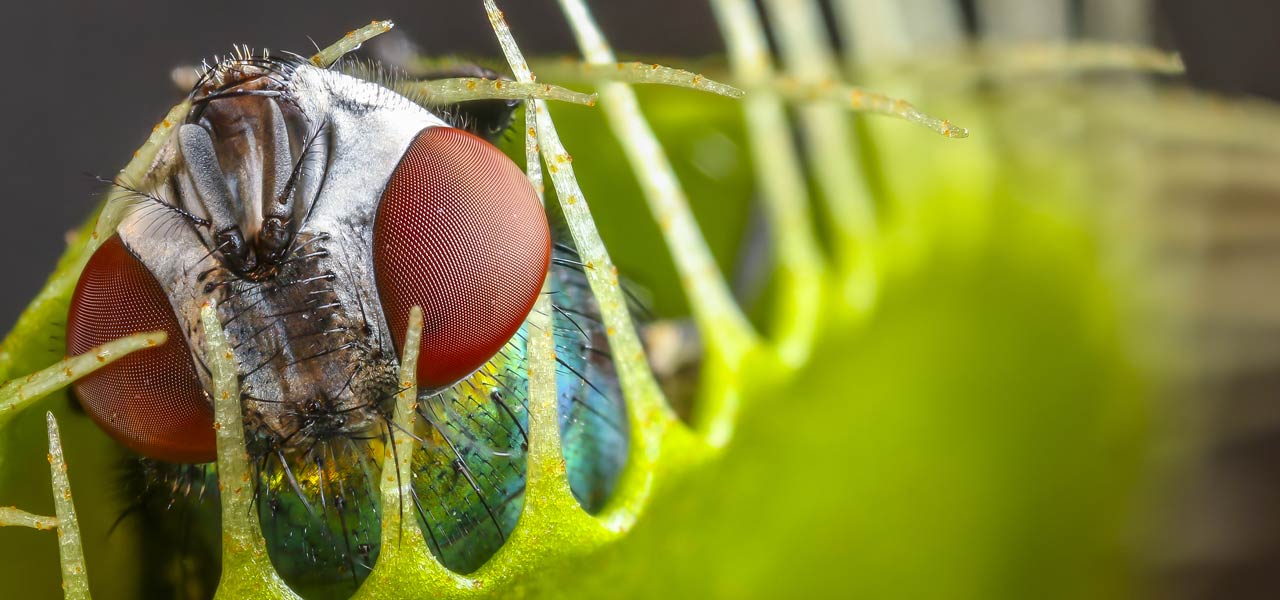Your Cart is Empty
spend R1000. 2kg or less. free shipping.
Menu

spend R1000. 2kg or less. free shipping.
bonsai
gardening
Orchids

Who eats what?
2 min read
Article written by Peter Hewitt of Pan's Carnivores. Be sure to read other articles by this South African carnivorous plant guru here.
Background
We've received a lot of queries about the ultimate Fly and pest busters so here's a breakdown of which carnivorous plant is the most effective plant for particular pests.
Sarracenia (Trumpet pitcher plants)
The best fly and roach catchers around!!
Once each trumpet has a few pitchers and once each opens up, it is open for business!!
The plant itself will catch as many flies and insects as can fit into each pitcher, which can be as many as hundreds, per pitcher, per day; ergo the taller and wider each pitcher on the plant gets, the more pests it can fit in the hatch.

Did you know that carnivorous plants are smart?
The Sarracenia produces pheromones and nectar trails, undetectable by us, which attract their prey and when they cannot resist and land on the plant it doses them with a chemical that makes them very happy, so that even if they don’t go into the mouth immediately, they are now hooked and will return to that exact plant (even if there are 10 just like it in the same area) until they drunkenly enter the pitcher’s mouth and slip into oblivion with a smile their face so that they don’t damage the plant.
Drosera (Sundews)
The ones to call on to bite them mosquitoes back!
Sundews don’t just look pretty, but are also highly effective at catching mosquitoes and fruit flies.
These wolves in sheep’s clothing attract insects to their sweet, sticky dew-drops where they get stuck; after which the tentacles curl around the insect to maximise the surface area contact.

Dionaea muscipula (Venus Fly Traps)
These iconic carnivores are one of very few plants capable of rapid movement.
While they are fast and AWESOME, they can only eat one fly/spider at a time, per head.
Each head closes about 4 times in its lifetime, so as much fun as it is, sticking our fingers in them to activate the trap unfortunately robs the plant of a meal.
Don’t fret though, because healthy fly traps will have more small traps growing than crossing the void.

Nepenthes (Tropical Pitcher Plants or Monkey Cups)
These pitchers do not discriminate and attract a wide range of foraging, flying and crawling insects. They are however particularly effective roach and ant eaters!
The bigger they get, the more they can eat and in time these guys can each get big enough to fit a wine bottle inside!!
Don't be surprised to see geckos and mice peering in and stealing snacks from within the pitcher's mouth. They seem to have a symbiotic relationship, as they themselves sometimes find themselves on the menu, although not as often as you might think.

Surely all those pests piling up will smell?
The plant wants to stay healthy and therefore not only digests insects quickly but also produces an antifungal inside it to prevent anything from rotting, so there is no foul smell whatsoever!
Read more articles about carnivorous plants here.
Leave a comment
Comments will be approved before showing up.
Recent Articles
- Enthusiasts Top Wiring Tips July 17, 2023
- Top fertilizing tips March 28, 2023
- Top watering tips February 13, 2023
- Creating Japanese Maple forests October 24, 2022
- How to dig bonsai material August 15, 2022
- How I style bonsai and you can too April 30, 2022
- Swamp Cypress Bonsai Styling July 03, 2021
- How to hide large scars quickly June 14, 2021
- 14 Tips for Field Growing Bonsai May 31, 2021
- Aquaria: An Introduction January 06, 2021

FREE SAMPLE GIVEAWAY!
We are giving away samples of our new product, SuperBoost fertilizer pellets.
A unique organic blend of Blood meal, Bone meal, Canola meal, Fish meal, Fish hydrolysate. Macro, micro and trace minerals. Plant natural stimulating hormones, enzymes and amino acids.




